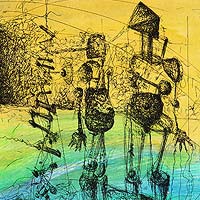Critiques

Introduction
by Luca Pietro Nicoletti, 2013
text in the catalogue “The sign incarnate”
This book sums up a singular series of graphic works produced by Francesca Magro spanning the years 2011-2012 with a view to an exhibition which will show the work in its entirety. An anomalous series as each individual copperplate engraving is of a different size when it is commonplace for cycles of this type to feature works of the same size nevertheless connected by a stylistic unity almost as if it were a single imaginary diary revealing a possible future humanity unnaturally modified by biotechnology to the point of becoming robotic with all that implies.
A group of specialists coming from different fields have interpreted specific aspects of the work each from his or her particular point of view. A similar experiment had been attempted in 2010 with the booklet Il corpo e la carne (published by Spazio Tadini of Milano), in which I, the psychoanalyst Giancarlo Ricci and painter Giancarlo Ossola contributed. We have attempted to expand our analysis this time, in particular towards the fields of graphology and philosophy together with firsthand witnesses to the artistís work and modus operandi.
It is thus clear that each contributorís approach shall be determined by his or her peculiar vision. It is in the very nature of the artistís work to require a wider perspective in order to fully explore its themes according to precise differentiated hermeneutical models, ranging from the very concept of sign to and its connection to writing (and with the “writing” of images) to the ethical and existentialist implications raised by these works. Some of these possible approaches draw inspiration from the images only to pursue autonomous paths as if the works were only a passage through which our thoughts transit; soliciting the viewers individual reflection is, of course, one of the purposes of art in general even when said paths were not intended by the artist. The articles present diverse personal experiences and possible approaches to Francescaís work, trying to gauge a meaning from a diversified reading of her work.
Alongside this we have, however, tried to keep a basis in the material existence of these works and their place in the artistís creative exploration. In this sense Andrea Angelucciís photographs play an important role as they not only document the single works but also portray the artist at work, intent on her engravings and draw from the artistís sketchbook, brimming with detailed and fluffy drawings Francesca has produced over the years. All of this has its roots in the development of the scene between the end of the seventies and the early eighties, formative years for the artist and decisive for her discovery of a personal artistic identity and the guidelines she has followed to the present day. Her work today bears witness to the coherence with what we could already decipher from her earliest works.
